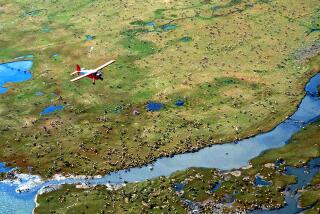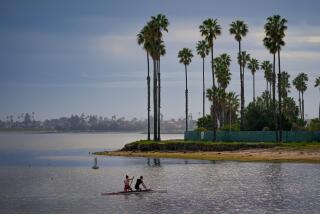Battle Lines Drawn in Maine Wilderness Project
- Share via
FRENCHTOWN TOWNSHIP, Maine — A proposed development at the gateway to Maine’s North Woods envisions nearly 1,000 house lots, two resorts, three recreational vehicle parks, a golf course and a marina. It would be the state’s biggest such project -- and opponents and supporters alike say its impact would be colossal.
Local officials hail the Plum Creek Timber Co.’s plan for the Moosehead Lake region as a potential shot in the arm for a part of Maine bypassed by economic growth. Towns near the North Woods have been losing population for years, and schools and hospitals are struggling.
Many businesses support the plan and discount critics’ fears.
Seated at a table at the Kokadjo Trading Post on a recent picture-perfect day, owner Fred Candeloro looked out of the window toward the western end of First Roach Pond -- where a far smaller Plum Creek development plan is already unfolding -- and began taking count.
“How many boats do you see out there? None! How many fishermen out there? None!” Candeloro said, his voice booming with emotion. “Where’s this overdevelopment they’re talking about?”
Others, however, say the latest development plan would forever change the region’s last great stretch of wilderness.
Five miles from the trading post, inside the rustic 1950s-era camp that she and her husband bought 20 years ago, Joan Wisher lamented the disappearance of the owls that used to lull her to sleep.
Their nests, the retired Massachusetts state trooper said, fell victim to construction crews who cut down trees and built roads to develop 89 building lots on and near the pond.
She suggests that the Plum Creek Timber Co. project is responsible for everything, from a worrisome foam on First Roach to noisy water skis zooming across the waters.
The emotionally charged battle over development in the Moosehead Lake region has spread as Plum Creek presses ahead with its development and conservation plan for 426,000 of its nearly 1 million acres in Maine. Vandals have twice defaced Plum Creek offices in the state.
To hikers, sportsmen and naturalists, Moosehead points the way into Maine’s North Woods, one of the most hallowed areas in the Northeast. Explored 150 years ago by Henry David Thoreau, it is a key part of a vast expanse of forest teeming with moose, deer and bear, and dotted with trout ponds and streams.
Under Plum Creek’s plan, 98% of the 426,000 acres would be protected from development for 30 years. There would be easements on 125 miles of hiking and snowmobile trails and permanent conservation of 180 miles of undeveloped waterfront.
The fate of the plan rests with a panel of private citizens, the Land Use Regulation Commission, which serves as the zoning board for the state’s 10.5 million acres of unorganized territory, most of it in the thinly populated, forested north.
The panel is in the early stages of what’s expected to be a yearlong review of Plum Creek’s 570-page application.
To its supporters, the project is a thoughtful blend of conservation and development, one that preserves the region’s longtime custom of allowing public access to private timberlands for fishing, hunting, hiking and snowmobiling.
“This is good for Maine because it’s maintaining Maine traditions,” said Jim Lehner, Plum Creek’s regional general manager.
Environmental groups, however, have denounced the project, saying it opens the door for sprawl that threatens to change the character of an area they regard as the heart and soul of Maine. They worry that while development would be permanent, the conservation provisions would last for only 30 years.
Cathy Johnson of the Natural Resources Council of Maine likes to display a satellite photo taken at night of the eastern half of the country.
The large patch of total darkness that makes up the North Woods poses a sharp contrast to the illuminated areas that surround it.
“That, in a nutshell, is the easiest way to explain to people why this is a national issue,” Johnson said. “It’s the largest undeveloped block of land east of the Mississippi, and it has national significance.”
Some opponents have an alternate vision, hoping to make it a part of a North Woods National Park. That proposal has stirred strong feelings but remains stalled in the face of opposition from political leaders and many residents of the region.
Plum Creek plans to develop groupings of house lots along already-developed waters such as Moosehead and Brassua lakes in much the same way it sited the 89 lots on First Roach Pond. And if the experience there is any measure, it’s a good bet that there will be no scarcity of buyers.
The First Roach lots, which went on the market for $60,000 to $100,000, have soared in value, real estate agent Dave Vaughn said. The response from buyers underscores a hunger for vacation properties in a wilderness setting six hours by car from Boston.
“I knew there was a demand -- I didn’t know how strong,” Vaughn said.
A boat ride down the length of the pond highlights the contrast between the new, clustered properties and older camps like retiree Joan Wisher’s that were built over the years in a scattershot manner. The older cottages, set close to the water and in some cases surrounded by lawns, would be banned under today’s more stringent standards that require 200 feet of frontage, a 100-foot setback and a forest canopy along the shore.
Candeloro, of the Kokadjo Trading Post, welcomes Plum Creek as a good neighbor and said its planned development is preferable to the hodge-podge of the past.
Conservation provisions included in the First Roach project, he said, ensure that the awe-inspiring scenery he sees from his store will remain.
“With the concept plan, that stays,” he said, pointing to the clear water, verdant forest and mountains in the distance. “That view is going to be here forever.”
But Wisher said the development had already led to a threefold increase in motor vehicle traffic. And she wondered how long the moose and eagles that frequent the lake would stick around once all the lots were filled with homes. She said the Plum Creek project now before the panel could place an RV park nearby, adding to the pressure on the area.
“It’s lost its magic,” she said. “What we have here is a treasure, a wilderness treasure.... But if we let suburban sprawl come all the way up here, nobody will have a place like this ever again.”
More to Read
Sign up for Essential California
The most important California stories and recommendations in your inbox every morning.
You may occasionally receive promotional content from the Los Angeles Times.










